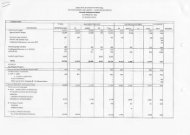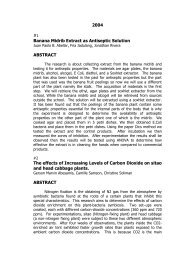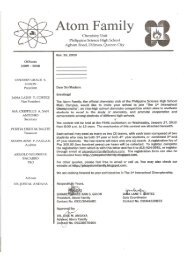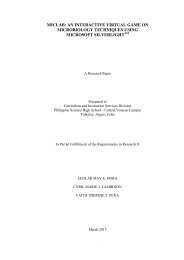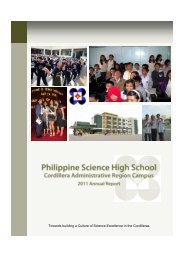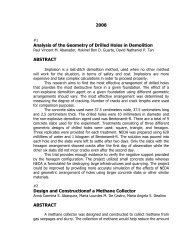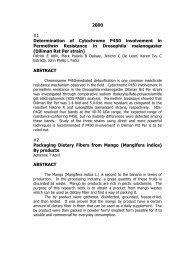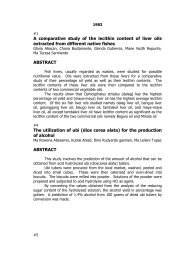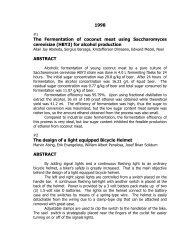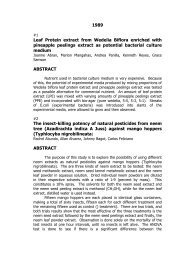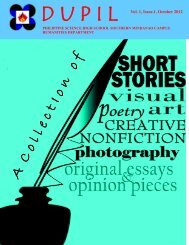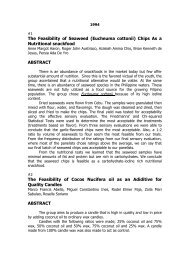Form 3: Curriculum Guide Page 1 of 11 - PSHS-CVC
Form 3: Curriculum Guide Page 1 of 11 - PSHS-CVC
Form 3: Curriculum Guide Page 1 of 11 - PSHS-CVC
You also want an ePaper? Increase the reach of your titles
YUMPU automatically turns print PDFs into web optimized ePapers that Google loves.
<strong>Form</strong> 3: <strong>Curriculum</strong> <strong>Guide</strong><br />
A. CURRICULUM GUIDE<br />
GRADE LEVEL: Grade 7 (1 st Year)<br />
SUBJECT AREA: English 1: Communication Arts in English 1 and Philippine Literature in English<br />
Content/ Topic Desired Learning Suggested<br />
Suggested<br />
Suggested Learning Time Frame<br />
Competencies Communicative Instructional<br />
Assessment Resources<br />
First Quarter<br />
Functions<br />
Strategies<br />
Strategies<br />
A. Learning 1. Identify one’s<br />
Self-inventory<br />
Inventory guide Web Resources 1 meeting<br />
Styles<br />
learning style(s)<br />
Discussion<br />
2. Apply knowledge <strong>of</strong><br />
one’s learning style<br />
to one’s strategy in<br />
studying/learning<br />
Sharing<br />
B. Study/<br />
3. Demonstrate<br />
Library Tour<br />
Poster on How to Web Resources 1meeting<br />
Research<br />
familiarity in using<br />
Orientation on Library Use the Library<br />
Skills, Library library materials<br />
Rules<br />
Student<br />
and Study 4. Exercise ethics in<br />
Lecture<br />
Commitment<br />
Skills, and<br />
Citing Sources<br />
citing sources<br />
Contract<br />
C. “Smart 5. Adopt techniques in<br />
Discussion sharing <strong>of</strong> Personal Study Web Resources 1 meeting<br />
Studying” by studying, learning<br />
techniques<br />
Schedule<br />
Dennis Arroyo and taking tests<br />
Brainstorming<br />
D. Review on 6. Identify the part <strong>of</strong> Asking questions Diagnostic test Worksheets<br />
1. Maclin, A. 3 meetings<br />
Parts <strong>of</strong><br />
speech<br />
Grammar Games (2004).<br />
Speech 7. Differentiate the<br />
Cloze Exercise Reference guide<br />
E. Review <strong>of</strong><br />
sentence parts<br />
to English.<br />
Basic<br />
Washington:<br />
F. Sentence Parts<br />
Holt, Rhinehart,<br />
G. Subject Verb 8. Recall the rule/s<br />
Lecture<br />
Quiz<br />
and Winston. 3 meetings<br />
Agreement 9. Infer grammar rules<br />
Exercises<br />
Writing Activities 2. Carrol, J.,<br />
from examples<br />
Wilson, E. &<br />
given<br />
Forlini, G.<br />
10. Observe rules<br />
(2001). Writing<br />
when writing<br />
and grammar.<br />
sentences<br />
Singapore:<br />
H. Pronoun- <strong>11</strong>. Define antecedents<br />
Lecture<br />
Quiz<br />
Pearson 2 meetings<br />
Antecedent in relation to<br />
Exercise<br />
Writing Activities Education South<br />
Agreement pronouns<br />
Asia Pte. Ltd.<br />
12. Use pronouns<br />
3. Guffey, M. &<br />
properly<br />
Seefer, C.<br />
<strong>Page</strong> 1 <strong>of</strong> <strong>11</strong>
<strong>Form</strong> 3: <strong>Curriculum</strong> <strong>Guide</strong><br />
I. Principal Parts<br />
<strong>of</strong> the Verbs<br />
and Tenses<br />
J. Introduction to<br />
Literature and<br />
Genres<br />
K. Philippine<br />
Mythology in<br />
English<br />
(depending on<br />
the regional<br />
campus) and<br />
the Short story<br />
L. Roots, Affixes,<br />
Bases<br />
M. A Collection <strong>of</strong><br />
Regional<br />
Myths (to be<br />
compiled by<br />
each teacher)<br />
13. Demonstrate<br />
mastery <strong>of</strong> the<br />
principal parts <strong>of</strong><br />
the verb through<br />
the correct use<br />
<strong>of</strong> the correct tense<br />
14. Differentiate forms<br />
and functions <strong>of</strong><br />
Philippine literary<br />
genres<br />
15. Explain insights<br />
about one’s cultural<br />
roots based on the<br />
text read<br />
16. Produce a<br />
myth/legend based<br />
on respective folk<br />
literary conventions<br />
17. Identify elements<br />
employed in a short<br />
story<br />
18. Decode unfamiliar<br />
vocabulary applying<br />
knowledge <strong>of</strong><br />
affixes<br />
19. Use prefixes and<br />
suffixes correctly<br />
20. Derive meaning<br />
from context<br />
21. Identify the main<br />
and<br />
subordinate ideas<br />
in written works<br />
22. Summarize ideas in<br />
one’s own words<br />
23. Determine the<br />
different purposes<br />
and methods <strong>of</strong><br />
writing<br />
24. Identify writer’s<br />
point <strong>of</strong> view and<br />
tone<br />
25. Interpret writer’s<br />
Narrating events and<br />
processes (laboratory<br />
experiments)<br />
Lecture/Discussion<br />
Grammar Games<br />
Drills/Worksheets<br />
Lecture<br />
Skits<br />
Comic strips<br />
Film viewing (film<br />
about native deities or<br />
mythology)<br />
Picture word<br />
meanings<br />
Word puzzles<br />
Word Wall / Word<br />
Bank<br />
Word Association<br />
Home Reading<br />
Assignment<br />
<strong>Page</strong> 2 <strong>of</strong> <strong>11</strong><br />
Quiz (2002).<br />
Essential <strong>of</strong><br />
English. Ohio:<br />
South-Western<br />
Thomas<br />
Composition <strong>of</strong> an<br />
original myths and<br />
legends based on<br />
respective folk lit<br />
conventions<br />
Learning.<br />
Eugenio,<br />
Damiana. (2005)<br />
Philippine Folk<br />
Literature: The<br />
Myths. Quezon<br />
City: UP Press<br />
- quizzes Grammar and<br />
Composition I<br />
(Prentice Hall)<br />
Activity Sheets<br />
Panel Discussion<br />
Book Report<br />
Long Test<br />
4 meetings<br />
6 meetings<br />
2 meetings<br />
2 meetings
<strong>Form</strong> 3: <strong>Curriculum</strong> <strong>Guide</strong><br />
meaning<br />
inferentially and<br />
literally<br />
26. State one’s<br />
personal opinions<br />
and assumptions<br />
from a writer’s<br />
through literary<br />
analysis<br />
Second Quarter<br />
A. Conjunctions 1. Construct compound<br />
and complex<br />
sentences<br />
using conjunctions<br />
B. Transition<br />
Words<br />
2. Use key idea<br />
sentences<br />
support sentences,<br />
transition words, and<br />
restatement in texts<br />
C. Prepositions 3. Employ prepositions<br />
to show<br />
relationships<br />
between nouns and<br />
pronouns<br />
D. Verbals 4. Differentiate verbals<br />
from verbs<br />
5. Compare and<br />
contrast the forms and<br />
functions <strong>of</strong> the different<br />
verbals<br />
E. Introduction to<br />
the Novel ( Pre-<br />
War Philippine<br />
Literature in<br />
English)<br />
6. Characterize the<br />
general nature <strong>of</strong><br />
literary works <strong>of</strong> the<br />
period by identifying<br />
common subjects,<br />
themes and styles<br />
7. Identify the themes <strong>of</strong><br />
Comparing and<br />
contrasting <strong>of</strong><br />
concepts events,<br />
people (science,<br />
history)<br />
Reporting<br />
Describing a process<br />
Giving directions and<br />
instructions<br />
Locating things and<br />
places<br />
Articulating<br />
experiences,<br />
observations, and<br />
opinions on<br />
contemporary issues<br />
<strong>Form</strong>ing judgments<br />
on social issues<br />
*Cloze<br />
*Discovery Approach<br />
*Deductive/Inductive<br />
Method<br />
<strong>Page</strong> 3 <strong>of</strong> <strong>11</strong><br />
*Letter writing using<br />
conjunctions<br />
*Lecture *Comic strip<br />
*Improvisations<br />
*Quiz<br />
*Drills and exercises<br />
*Sentence<br />
constructions<br />
*Dialogues<br />
*Deductive/Inductive<br />
Method<br />
*Lecture<br />
*Brainstorming<br />
*Power Point<br />
Presentations<br />
*Mapping<br />
*Song<br />
*Quiz<br />
*Cinquain<br />
*Speech<br />
*Role-playing<br />
*Mock-debate<br />
*Quiz<br />
*Poetry Reading<br />
*Character Portrayal<br />
*Choral Reading<br />
Grammar and<br />
Composition I<br />
(Prentice Hall)<br />
Grammar and<br />
Composition I<br />
(Prentice Hall)<br />
Grammar and<br />
Composition I<br />
(Prentice Hall)<br />
Activity Sheets<br />
Grammar and<br />
Composition I<br />
(Prentice Hall)<br />
MS PPT<br />
Abad, G.H.<br />
(2002) The<br />
Likhaan<br />
Anthology <strong>of</strong><br />
Philippine<br />
Literature in<br />
2 meetings<br />
1 meeting<br />
2 meetings<br />
3 meetings<br />
9 meetings
<strong>Form</strong> 3: <strong>Curriculum</strong> <strong>Guide</strong><br />
given literary<br />
selections<br />
F. Antonyms and<br />
Synonyms<br />
G. Figures <strong>of</strong><br />
Speech<br />
H. Without Seeing<br />
the Dawn<br />
(Stevan<br />
Javellana)<br />
8. Optimize vocabulary<br />
using synonyms and<br />
antonyms<br />
9. Unlock meanings<br />
through context clues<br />
10. Identify and explain<br />
poetic devices, use<br />
<strong>of</strong> local color,<br />
figurative language,<br />
and sensory images<br />
in literary forms<br />
<strong>11</strong>. Explain meaningful<br />
and symbolic lines<br />
from the selection<br />
read<br />
12. Cite illustrative<br />
examples<br />
13. Create figures <strong>of</strong><br />
speech<br />
14. Identify the main<br />
and subordinate<br />
ideas in written<br />
works<br />
15. Summarize ideas in<br />
one’s own words<br />
16. Recognize different<br />
purposes and<br />
methods <strong>of</strong> writing<br />
17. Identify writer’s<br />
point <strong>of</strong> view and<br />
tone<br />
18. Interpret writer’s<br />
meaning<br />
inferentially<br />
and literally<br />
19. Separate one’s<br />
personal opinions<br />
and assumptions<br />
from a writer’s<br />
Choosing the<br />
appropriate word for<br />
the right context<br />
*Word Games *Word Association<br />
*Sentence<br />
Construction<br />
*Quiz Bee<br />
* Lecture<br />
* Poem Analysis<br />
* SRA<br />
Home Reading<br />
Assignment<br />
<strong>Page</strong> 4 <strong>of</strong> <strong>11</strong><br />
*Word Games<br />
*List Poem<br />
Worksheets using<br />
Graphic Organizers /<br />
Long Test<br />
English from<br />
1900 to the<br />
present<br />
Grammar and<br />
Composition I<br />
(Prentice Hall)<br />
SRA<br />
Grammar and<br />
Composition I<br />
(Prentice Hall)<br />
3 meetings<br />
4 meetings<br />
2 meetings
<strong>Form</strong> 3: <strong>Curriculum</strong> <strong>Guide</strong><br />
Third Quarter<br />
A. Sentence<br />
Patterns<br />
B. Sentence<br />
Structures<br />
C. Sentence<br />
Functions<br />
through literary<br />
analysis<br />
1. Recognize the<br />
components <strong>of</strong><br />
basic sentence<br />
patterns<br />
2. Identify sentence<br />
patterns in given<br />
sentences<br />
3. Construct effective<br />
sentences using<br />
basic sentence<br />
patterns<br />
4. Recognize the<br />
components <strong>of</strong><br />
each sentence<br />
structure (simple,<br />
compound,<br />
complex,<br />
compoundcomplex)<br />
5. Construct various<br />
sentence<br />
structures using<br />
appropriate<br />
conjunctions<br />
6. Write a short<br />
paragraph using<br />
the sentence<br />
structures<br />
7. Recognize the<br />
functions <strong>of</strong><br />
sentences<br />
8. Classify sentences<br />
by function<br />
(Declarative,<br />
Interrogative,<br />
Imperative,<br />
Exclamatory)<br />
9. Analyze how<br />
sentences are<br />
formed/<br />
Answering essay type<br />
questions<br />
Writing summaries<br />
using clear, concise<br />
sentences<br />
Work Book (Drill)<br />
Grammar Games<br />
Multi-media-aided<br />
Lecture/Discussions<br />
Lecture/Interactive -<br />
discussion<br />
Fish bowl activity<br />
Slide show<br />
presentation<br />
Cloze Test<br />
<strong>Page</strong> 5 <strong>of</strong> <strong>11</strong><br />
Collaborative Work<br />
(Group<br />
Story/Composition)<br />
with provided rubrics<br />
Print / TV<br />
advertisement (by<br />
group)<br />
Paper and Pencil<br />
Test<br />
Short and Long Quiz<br />
Short Speech<br />
Delivery<br />
Grammar and<br />
Composition I<br />
(Prentice Hall)<br />
Activity Sheets<br />
7 meetings
<strong>Form</strong> 3: <strong>Curriculum</strong> <strong>Guide</strong><br />
punctuated<br />
according to<br />
function<br />
D. Punctuations 10. Use proper<br />
punctuation marks<br />
in constructing<br />
effective<br />
sentences.<br />
<strong>11</strong>. Punctuate the<br />
sentences<br />
12. Write correct<br />
sentences/paragra<br />
ph using<br />
appropriate<br />
punctuation marks<br />
E.<br />
13. Use structural,<br />
Connotation and lexical, and<br />
Denotation<br />
contextual devices<br />
(denotation and<br />
connotation) in<br />
deriving the<br />
meaning <strong>of</strong><br />
unknown words<br />
and ambiguous<br />
discourse<br />
F. Introduction to 14. Identify the<br />
Drama<br />
elements <strong>of</strong> drama<br />
15. Differentiate<br />
drama from other<br />
literary<br />
forms/genres<br />
16. Associate<br />
characters and<br />
given situations <strong>of</strong><br />
the play to reality<br />
through role<br />
playing<br />
H. Bamboo in the 17. Identify main and<br />
Wind (Azucena subordinate ideas<br />
Grajo-Uranza) in written works<br />
18. Summarize ideas<br />
in one’s own<br />
words<br />
Composing written<br />
reports<br />
Making predictions<br />
and anticipating<br />
outcomes<br />
Drill<br />
Worksheet<br />
Multi-media aided<br />
presentation<br />
Contextual Clues<br />
Word association<br />
Word links<br />
Dramatic Reading<br />
Round Table<br />
Discussion<br />
Film Viewing (<strong>of</strong> a play<br />
turned movie)<br />
Home Reading<br />
Assignment<br />
<strong>Page</strong> 6 <strong>of</strong> <strong>11</strong><br />
Internet sources<br />
Grammar books<br />
Other<br />
references<br />
1 meetings<br />
Quiz 1 meeting<br />
Short Dramatic<br />
Presentations<br />
(with provided<br />
rubrics)<br />
Worksheet with<br />
Graphic Organizers<br />
Long Test<br />
4 meetings<br />
2 meeting
<strong>Form</strong> 3: <strong>Curriculum</strong> <strong>Guide</strong><br />
19. Identify writer’s<br />
point <strong>of</strong> view and<br />
tone<br />
20. Interpret the<br />
writer’s literal and<br />
figurative meaning<br />
Fourth Quarter<br />
A. Phrases 1. Differentiate phrase<br />
from clause and<br />
sentence<br />
2. Supply missing<br />
phrases to<br />
complete<br />
B. Fragments, runon<br />
sentences,<br />
fused sentences<br />
sentences<br />
3. Identify fragments,<br />
run-ons and fused<br />
sentences<br />
4. Revise fragments,<br />
run-ons and fused<br />
sentences<br />
C. Clauses 5. Differentiate<br />
dependent from<br />
independent clause<br />
6. Write sentences<br />
showing logical<br />
coordination and<br />
subordination <strong>of</strong><br />
D. Introduction to<br />
Poetry and<br />
Contemporary<br />
Philippine<br />
Literature in<br />
English<br />
ideas<br />
7. Distinguish imagery<br />
and poetic devices<br />
used in a poem<br />
8. Make<br />
generalizations<br />
and significant<br />
abstractions from<br />
different reading<br />
materials designed<br />
for information,<br />
pleasure and<br />
appreciation.<br />
9. Express<br />
appreciation <strong>of</strong><br />
one’s identity and<br />
Supporting opinions Discussion<br />
Sentence Completion<br />
Company/Product<br />
Print Ads Analysis<br />
Discussion<br />
Grammar Drill<br />
Peer Editing<br />
Discussion<br />
Drills<br />
Model Letter Analysis<br />
Poetry Reading<br />
Poem Interpretation<br />
and Discussion<br />
Story Mapping<br />
Character Analysis<br />
Directed Reading –<br />
Teaching Activity<br />
(DRTA)<br />
K-W-L<br />
Skimming and<br />
Scanning<br />
<strong>Page</strong> 7 <strong>of</strong> <strong>11</strong><br />
Print Ads Making<br />
Photo Caption<br />
Writing<br />
Short Lab Report<br />
Writing<br />
Letter Writing<br />
(Request/ Intent/<br />
Excuse)<br />
Quiz<br />
Poetry Writing<br />
Group Reporting<br />
through PowerPoint<br />
Presentation<br />
Short Reflective/<br />
Informative Essay<br />
Writing<br />
Outlining an Essay<br />
Mock Author<br />
Interview<br />
Grammar and<br />
Composition I<br />
(Prentice Hall)<br />
Activity Sheets<br />
3 meetings<br />
3 meetings<br />
3 meetings<br />
1.Abad, G.H. 8 3 meetings<br />
(2002). The<br />
Likhaan<br />
Anthology <strong>of</strong><br />
Philippine<br />
Literature in<br />
English from<br />
1900 to the<br />
present<br />
2. Crogan. R.V<br />
(1998). The<br />
Development <strong>of</strong><br />
Philippine<br />
Literature in<br />
English
<strong>Form</strong> 3: <strong>Curriculum</strong> <strong>Guide</strong><br />
cultural heritage<br />
through writing<br />
poems<br />
10. Interpret the text’s<br />
meaning<br />
inferentially and<br />
literally<br />
<strong>11</strong>. Demonstrate<br />
appreciation <strong>of</strong><br />
literary elements <strong>of</strong><br />
poems, short<br />
stories and essays<br />
through literary<br />
analysis<br />
12. Judge the<br />
characters’<br />
motives and<br />
attitudes based on<br />
their actions,<br />
thoughts and<br />
descriptions<br />
through character<br />
analysis<br />
13. Identify and explain<br />
the theme(s) <strong>of</strong> the<br />
poem/short story<br />
14. Summarize ideas<br />
and/or information<br />
contained in a text<br />
15. Determine the<br />
author’s writing<br />
style and purpose<br />
16. Identify the writer’s<br />
point <strong>of</strong> view and<br />
tone<br />
17. Point out the<br />
Filipino cultural<br />
values and heritage<br />
underscored in the<br />
poems/ short<br />
stories/ essays<br />
through details<br />
analysis<br />
<strong>Page</strong> 8 <strong>of</strong> <strong>11</strong><br />
Book Jacket Making<br />
or Movie Poster<br />
Making<br />
3. Balarbar,<br />
C.V., Bolascon,<br />
K.A. & Remoto,<br />
D. R. (2010).<br />
English GEMS<br />
in Philippine<br />
Literature
<strong>Form</strong> 3: <strong>Curriculum</strong> <strong>Guide</strong><br />
E. Idiomatic<br />
Expressions<br />
F. Critical Multi-<br />
Media Viewing<br />
G. “The Last Time I<br />
Saw Mother” by<br />
Arlene Chai<br />
18. Unlock the<br />
meaning <strong>of</strong><br />
idiomatic<br />
expressions<br />
through context<br />
clues<br />
19. Listen to an<br />
informative text<br />
20. Use idiomatic<br />
expressions in<br />
speech and writing<br />
21. Identify the main<br />
ideas or messages<br />
<strong>of</strong> editorial<br />
cartoons, print ads,<br />
comic strips, etc.<br />
22. Summarize the<br />
ideas found in<br />
multi-media texts<br />
using<br />
one’s own words<br />
23. Determine the<br />
different purposes<br />
and methods <strong>of</strong><br />
multi-media<br />
messages<br />
24. Create one’s own<br />
multi-media<br />
message<br />
25. Identify main and<br />
subordinate ideas<br />
in written works<br />
26. Summarize ideas in<br />
one’s own words<br />
27. Recognize different<br />
purposes and<br />
methods <strong>of</strong> writing<br />
28. Identify writer’s<br />
point <strong>of</strong> view and<br />
tone<br />
29. Interpret writer’s<br />
meaning<br />
inferentially and<br />
Paraphrasing Discussion<br />
Viewing Famous<br />
Movie Excerpts and<br />
Analyzing Idiomatic<br />
Dialogs<br />
Listening to an<br />
Informative Speech*<br />
Process writing Actual Viewing<br />
Content Analysis<br />
Criticizing<br />
Home Reading<br />
Assignment<br />
<strong>Page</strong> 9 <strong>of</strong> <strong>11</strong><br />
Impromptu Speech 2 meetings<br />
Short Informative<br />
Commercial<br />
(Infomercial) Making<br />
National and<br />
Local<br />
Newspapers<br />
Print Ads<br />
3 meetings<br />
Long Test 2 meetings
<strong>Form</strong> 3: <strong>Curriculum</strong> <strong>Guide</strong><br />
literally<br />
30. Separate one’s<br />
personal opinions<br />
and assumptions<br />
from a writer’s<br />
Note: Items in Boldface are the suggested Special Projects for each quarter.<br />
B. HARMONIZED GRADING SYSTEM<br />
Periodic Exam 30%<br />
Quizzes, Long Tests and Performance-based Tasks 30%<br />
Special Projects 20%<br />
Other Tasks (Recitation/Homework/Seatwork/Groupwork) 20%<br />
_____________________<br />
TOTAL 100%<br />
C. WRITTEN EXAMINATIONS<br />
6-8 Quizzes<br />
At least one Long Test composed <strong>of</strong> 50-60 points<br />
At least two special projects<br />
D. APPENDIX: A List <strong>of</strong> Suggested Selections per Quarter<br />
1 st Quarter: Philippine Folk<br />
Literature in English<br />
Asuang Steals Fire From Gugurang<br />
Origin <strong>of</strong> this World<br />
The Quarrel <strong>of</strong> the Volcanoes<br />
Samal Genesis<br />
The Bontoc Legend <strong>of</strong> Lumawig<br />
The Creation <strong>of</strong> the Earth and the<br />
First People<br />
The Bukidnon Ascension to Heaven<br />
How the World was Created<br />
The Man and Woman <strong>of</strong> the Bamboo<br />
Bila-an Genesis<br />
Children <strong>of</strong> the Skyworld<br />
The Life <strong>of</strong> Lam-Ang<br />
The Three Heroes <strong>of</strong> Ibalon<br />
2 nd Quarter: Pre-War Philippine<br />
Literature in English<br />
Stories:<br />
The Mats( Francisco Arcellana)<br />
The Bread <strong>of</strong> Salt (N.V.M. Gonzalez)<br />
How My Brother Leon Brought Home<br />
A Wife (Manuel Arguilla)<br />
Poems:<br />
Moonlight on Manila Bay (Fernando<br />
M. Maramag)<br />
Come Home, Heroes (Bienvenido N.<br />
Santos)<br />
I Can No More Hear Love’s (Jose<br />
Garcia Villa)<br />
I Have Begrudged the Years (Angela<br />
C. Manalang-Gloria)<br />
<strong>Page</strong> 10 <strong>of</strong> <strong>11</strong><br />
3 rd Quarter: Post-War Philippine<br />
Literature in English<br />
Stories:<br />
Distance to Andromeda (Gregorio<br />
Brillantes)<br />
The Wedding Dance (Amador<br />
Daguio)<br />
May Day Eve (Nick Joaquin)<br />
Poems:<br />
Bonsai (Edith Tiempo)<br />
The Fragrance <strong>of</strong> Summertime<br />
(Oscar de Zuniga)<br />
Drama:<br />
Oli Impan (Alberto Florentino)<br />
The World is an Apple (Alberto<br />
Florentino)<br />
4 th Quarter: Contemporary<br />
Philippine Literature in English<br />
Poems:<br />
Diaspora (Oscar Picazo)<br />
Candles (Danton Remoto)<br />
Restless (Cecilia Borromeo)<br />
Batik Maker (Virginia Moreno)<br />
Letter to Pedro (Rene Estrella Amper)<br />
Essay:<br />
There’s a Teenager in the House<br />
(Kerima Polotan-Tuvera)<br />
Goodbye Superboy (Max Soliven)<br />
Where’s the Patis? (Carmen<br />
Guerrero-Nacpil)<br />
Story:<br />
Life Is a Three-Ring Circus (Jose A.<br />
Quirino)<br />
Faith, Love, Time and Dr. Lazaro
<strong>Form</strong> 3: <strong>Curriculum</strong> <strong>Guide</strong><br />
HRA: A compilation <strong>of</strong> Regional<br />
Folk Literature (in English)<br />
HRA: Without Seeing the Dawn<br />
(Stevan Javellana)<br />
Season <strong>of</strong> Grace (N.V.M. Gonzales)<br />
<strong>Page</strong> <strong>11</strong> <strong>of</strong> <strong>11</strong><br />
HRA: Bamboo in the Wind<br />
(Azucena Grajo-Uranza)<br />
Dog eaters (Jessica Hagedorn)<br />
(Gregorio C. Brillantes)<br />
The Visitation <strong>of</strong> the Gods (Gilda<br />
Cordero-Fernando)<br />
A House Full <strong>of</strong> Daughters (Kerima<br />
Polotan-Tuvera)<br />
The Day <strong>of</strong> the Locusts (Leoncio P.<br />
Deriada)<br />
The Wireless Tower (N.V.M.<br />
Gonzales)<br />
House at the Zapote Street (Nick<br />
Joaquin)<br />
Pr<strong>of</strong>essor Quemada’s Last Words<br />
(Eric Gamalinda)<br />
*Speech:<br />
Blond and Blue Eyes (Patricia<br />
Evangelista)<br />
HRA: The Last Time I Saw Mother<br />
(Arlene Chai)<br />
Soledad’s Sister (Jose Dalisay ,Jr.)



